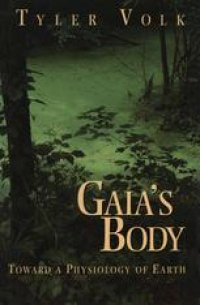
Ebook: Gaia’s Body: Toward a Physiology of Earth
Author: Tyler Volk (auth.)
- Tags: Earth Sciences general, Geoecology/Natural Processes, Nature Conservation, Ecology
- Year: 1998
- Publisher: Copernicus
- Edition: 1
- Language: English
- pdf
Is Earth alive? Put more rigorously, is the biosphere a self- sustaining meta-organism? This is the essence of Gaia theory: if the biosphere really is a single coherent system, then it must have something like a physiology. It must have systems and processes that perform living functions. OK, then, what systems, what processes, what functions? Gaia's Body is Tyler Volk's answer to this question. In this book, he describes the environment that enables the biosphere to exist; various ways of looking at its "anatomy" and "physiology," the major biogeographical regions such as rainforests, deserts, and tundra; the major substances the biosphere is made of; and the chemical cycles that keep it in balance. He then looks at the question of whether there are any long-term trends in earth's evolution--is Gaia growing colder? more complex?--and examines the role of humanity in Gaia's past and future. Adherents and skeptics both have often been concerned that Gaia theory contains too much goddess and too few testable hypotheses. This is the book that describes, for scientists, students, and lay readers alike, the theory's firm basis in science.
Is Earth alive? Put more rigorously, is the biosphere a self- sustaining meta-organism? This is the essence of Gaia theory: if the biosphere really is a single coherent system, then it must have something like a physiology. It must have systems and processes that perform living functions. OK, then, what systems, what processes, what functions? Gaia's Body is Tyler Volk's answer to this question. In this book, he describes the environment that enables the biosphere to exist; various ways of looking at its "anatomy" and "physiology," the major biogeographical regions such as rainforests, deserts, and tundra; the major substances the biosphere is made of; and the chemical cycles that keep it in balance. He then looks at the question of whether there are any long-term trends in earth's evolution--is Gaia growing colder? more complex?--and examines the role of humanity in Gaia's past and future. Adherents and skeptics both have often been concerned that Gaia theory contains too much goddess and too few testable hypotheses. This is the book that describes, for scientists, students, and lay readers alike, the theory's firm basis in science.
Is Earth alive? Put more rigorously, is the biosphere a self- sustaining meta-organism? This is the essence of Gaia theory: if the biosphere really is a single coherent system, then it must have something like a physiology. It must have systems and processes that perform living functions. OK, then, what systems, what processes, what functions? Gaia's Body is Tyler Volk's answer to this question. In this book, he describes the environment that enables the biosphere to exist; various ways of looking at its "anatomy" and "physiology," the major biogeographical regions such as rainforests, deserts, and tundra; the major substances the biosphere is made of; and the chemical cycles that keep it in balance. He then looks at the question of whether there are any long-term trends in earth's evolution--is Gaia growing colder? more complex?--and examines the role of humanity in Gaia's past and future. Adherents and skeptics both have often been concerned that Gaia theory contains too much goddess and too few testable hypotheses. This is the book that describes, for scientists, students, and lay readers alike, the theory's firm basis in science.
Content:
Front Matter....Pages i-xvii
Breathing of the Biosphere....Pages 1-29
A Global Holarchy....Pages 31-61
Outer Light, Inner Fire....Pages 63-92
The Parts of Gaia....Pages 93-124
Worldwide Metabolisms....Pages 125-153
Embodied Energy....Pages 155-187
The Music of This Sphere....Pages 189-219
Gaia in Time....Pages 221-252
Back Matter....Pages 253-269
Is Earth alive? Put more rigorously, is the biosphere a self- sustaining meta-organism? This is the essence of Gaia theory: if the biosphere really is a single coherent system, then it must have something like a physiology. It must have systems and processes that perform living functions. OK, then, what systems, what processes, what functions? Gaia's Body is Tyler Volk's answer to this question. In this book, he describes the environment that enables the biosphere to exist; various ways of looking at its "anatomy" and "physiology," the major biogeographical regions such as rainforests, deserts, and tundra; the major substances the biosphere is made of; and the chemical cycles that keep it in balance. He then looks at the question of whether there are any long-term trends in earth's evolution--is Gaia growing colder? more complex?--and examines the role of humanity in Gaia's past and future. Adherents and skeptics both have often been concerned that Gaia theory contains too much goddess and too few testable hypotheses. This is the book that describes, for scientists, students, and lay readers alike, the theory's firm basis in science.
Content:
Front Matter....Pages i-xvii
Breathing of the Biosphere....Pages 1-29
A Global Holarchy....Pages 31-61
Outer Light, Inner Fire....Pages 63-92
The Parts of Gaia....Pages 93-124
Worldwide Metabolisms....Pages 125-153
Embodied Energy....Pages 155-187
The Music of This Sphere....Pages 189-219
Gaia in Time....Pages 221-252
Back Matter....Pages 253-269
....